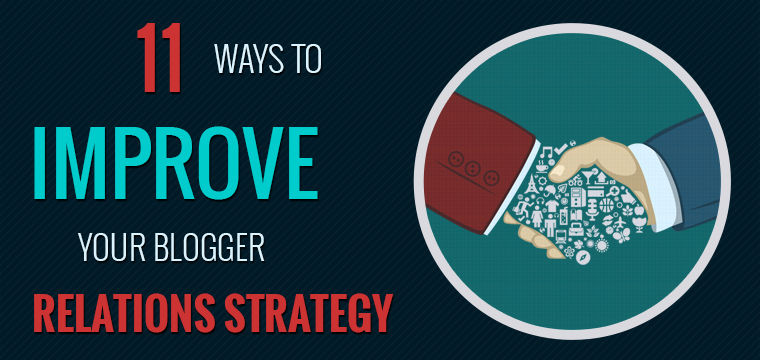As consumers seek out their own brand information when making purchase decisions, the importance of blogger relations in content and digital marketing strategy is increasing. Therefore, the way in which marketers work with bloggers needs to morph into a more tangible strategy.
It’s no news that bloggers are a great medium to market with influencers who then market to a super targeted network for your brand. However, the ways in which marketers get the attention of the bloggers, cultivate a relationship with them, and execute campaigns is going to become a little more structured and measurable.
In order to keep my network ahead of the game—that’s you—I put together this post. Take a look at the path blogger outreach is on and the trends that will make for really strong blogger outreach efforts so that you stay ahead of your competitors when it comes to working with bloggers.
#1 – Increased Compensation
As more and more marketers see the value in efforts involving bloggers, bloggers are realizing the value they bring and are demanding better compensation.
Earlier it used to be easier for brands to get placement by writing guest posts for or offering bloggers physical products in return for a mention on their blogs. Now more and more bloggers insist on monetary compensation on top of content and products for review.
So, be prepared to pay for mentions, even placement of guest posts. Set a budget before even reaching out.
Also be prepared to set “qualifiers” in place before you reach out. Define a minimum MozRank, traffic requirement or social following so that you know which bloggers to pay. Segment them into different groups so you know exactly what to offer as the relationship unfolds.
#2 – Mid-Level Bloggers Are Getting Bigger
While segmenting bloggers and compensating them based on qualifiers will be extremely important, contacting more bloggers with lesser reach will also find favor with marketers.
Research shows that mid-level bloggers can often times have more loyal and engaged audiences because they can keep up with and stay in communication with their smaller networks. In fact, reaching out to a bigger number of mid-level influencers can achieve more brand mentions while also being easier on the budget according to this study. (Remember you’re setting monetary compensation qualifiers so you can track and see if this holds true for you.)
Niche bloggers have super targeted audiences so it’s very beneficial to gain a mention from these bloggers and work with them if you’re selling niche products yourself.
#3 – No Strings Attached Introductions
As bloggers are becoming increasingly valuable, the number of brands reaching out to them and forming real relationships is also increasing, making it more of a digital battleground so to speak.
Therefore, like I mentioned earlier, the way in which you pitch and engage with your bloggers from the very beginning is more important than ever. I’ve seen a lot of luck with the “no strings attached” approach.
With this approach, you introduce yourself and your brand to the blogger without laying out expectations, contracts or being too abrasive with forming a relationship. Check out this case study on how Lorna Jane, an active apparel company, does blogger outreach. They simply send the blogger an introductory email and a link to pick out one of their products for free from and let the relationship grow organically.
This approach leads to higher response rates, stronger relationships and posts that are based on sincere and valuable brand shout outs.
#4 – Visual Post Additions
It’s no secret that people want easy to digest pieces of information. This along with the fact that you only have three seconds to draw people’s attention to a blog post means that visual additions to a post are becoming more important than ever for the digital audiences.
Though it’s usually up to the blogger to craft and put up the post, it’s your job to do what you can to make the post or mention represent your brand in the best way possible.
Here are some things you can do to help the blogger along the road to creating a visually appealing post without seeming overbearing:
- Attach professional images of your logo and product.
- Create a graph or a pie chart to depict any data or information that you think the blogger would like to include in their post.
- Ask the blogger if they want you to create a quiz, a small infographic, or something of the like for the post. Usually they’ll be happy you offered!
- Maybe the blogger is posting a recipe or DIY instructions. Type them out in a visually appealing way for the blogger to insert into their post.
- Don’t be afraid to get creative, the worst the blogger will say is “No, thanks.”
#5 – Bloggers as Advocates
One of the biggest ways blogger outreach is evolving is that bloggers are becoming some of your brand’s strongest advocates.
Instead of reaching out once and paying for a post, brands are realizing the value of ongoing relationships for continuous mentions. These types of mentions cause more action because they fit more organically with the bloggers’ content when a brand comes up in more than one post and because the mentions seem and are more sincere.
To gather ongoing mentions, it’s more important than ever to foster relationships and keep in touch with bloggers who like your brand. Their mentions are worth their weight in gold and it’s worth your time to create a community of bloggers who love your brand.
Here are some things to try to move bloggers to become advocates for your brand:
- Continually send free product samples to your network of bloggers.
- Send a monthly email to inform bloggers of news related to your brand and give them exclusive information.
- Ask for their input on brand and product changes. Make them feel a part of decision making process.
- Send them infographics and other forms of media that you know their readers would find interesting.
- Pay them for a series of posts over a few months or a year instead of just one post.
- Cross promote them on your own channels.
#6 – Influx in Creative Campaigns
Because a guest post or a casual brand mention is becoming common, you need to stay a step ahead of the game and create more creative outreach campaigns. I’m beginning to see a lot more interesting ways to get the attention of bloggers as well as more creative actual campaigns when working with bloggers.
Blogger events are becoming more popular as brands are seeing real results and make for a more creative, in depth and authentic post.
Gamification such as hosting giveaways with a blogger and other contests is another way to get the blogger and their network actively involved with your brand. Vitamix did a series of giveaways with mom bloggers and required social likes and shares to count as an entry to win their blender.
In addition to creative campaign tactics, I think we’ll see more and more brands trying to woo bloggers by sending them creative products.
#7 – Blogger Events
Events are a great way to get a handful of bloggers in one place and give them a hands-on and detailed experience with your brand. The best events speak to the bloggers and their interests rather than promote their brand the whole time. The focus therefore is never on your brand but on the blogger.
Check out this Forbes article on a blogger outreach event that Pizza Hut hosted. Not only did they fly bloggers to one place to educate them on their new product, they also hosted a fun filled weekend for them.
#8 – Transition from Informal to Structure
Random outreach emails and pleas for brand mentions are rapidly dying due to their ineffectiveness. Instead, structured campaigns that involve personalized emails to bloggers, compensation for mentions and fostering relationships with them is the only strategy to actually make blogger outreach work for your brand.
I think the most noticeable strategy I’ve seen lately when it comes to structured relationships between brands and bloggers is that brands will have bloggers write a series of posts over time instead of focusing on a one-off campaign.
More and more brands should have dedicated resources for outreach purposes. If you can’t spare any in-house, hire an agency to do it for you over the long-term.
#9 – Definition of Goals
This tactic also includes setting qualifiers before reaching out to bloggers, as also mentioned previously in this post. Because blogger relations will be more of a solid strategy, goals need to be defined before setting out finding bloggers and forming those amazing relationships.
Defining goals is the first step. After that, determine which types of bloggers to find and reach out to.
- Are you after simple brand awareness?
- Are you trying to promote a new product/service?
- Do you want to guest post?
- Perhaps you want to strengthen your brand authority on a topic?
- Do you have an event or epic piece of content to promote?
#10 – Social Engagement
Because bloggers are bombarded with pitches, it’s wise to engage socially with a blogger before emailing them your proposal to work together. Instead of rushing into things, you may want to try the following:
- Commenting on their blog posts
- Tweeting them a question
- Linking to their posts in your own posts
- Finding them on other social channels
- Sharing their posts on Google +
This way, when you show up in their inbox, it won’t be the first time the blogger has heard of you and they’ll be a lot more receptive to opening your email and reading what you have to say.
Engage with bloggers throughout the campaign and cultivate a relationship; don’t just engage during the introductory process. When a blogger posts about you, share it on your own channels. Additionally, periodically share their work that doesn’t mention your brand to foster an ongoing social relationship with them.
#11 – Blogger Inclusion vs. Extension
When we take into consideration all the trends and what works and what doesn’t in blogger outreach, one thing stands out—including the blogger in your brand instead of viewing them as an extension of your brand.
Bloggers are no longer individuals who you exchange a casual email with and never talk to again. Instead, the best blogger strategies for digital marketing this year will be those that include the bloggers in the brand.
Bloggers wear many hats now. They are consumers, advocates, influencers, opinion givers, problem solvers, and essentially some of your brands biggest assets.
As a marketer it’s your job to provide opportunities to allow them to wear all of these hats in a way that works to your brand’s advantage. Keep them in the loop, send them products and information before the rest of the world has access to it, ask for their opinion, compensate them well, and promote them on your channels.
Keeping in mind that bloggers are a part of your brand instead of an external factor will make for a strong and effective strategy.
What new trends have you seen lately in terms of blogger relations? Please share in the comments below. I would love to hear from you!
38,903 total views, 2 views today

